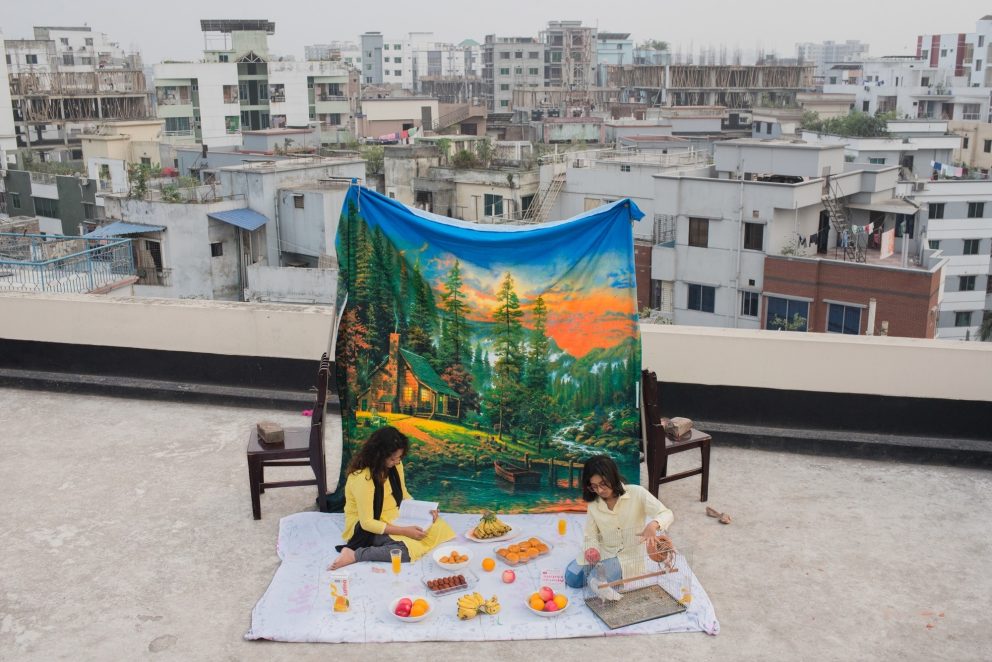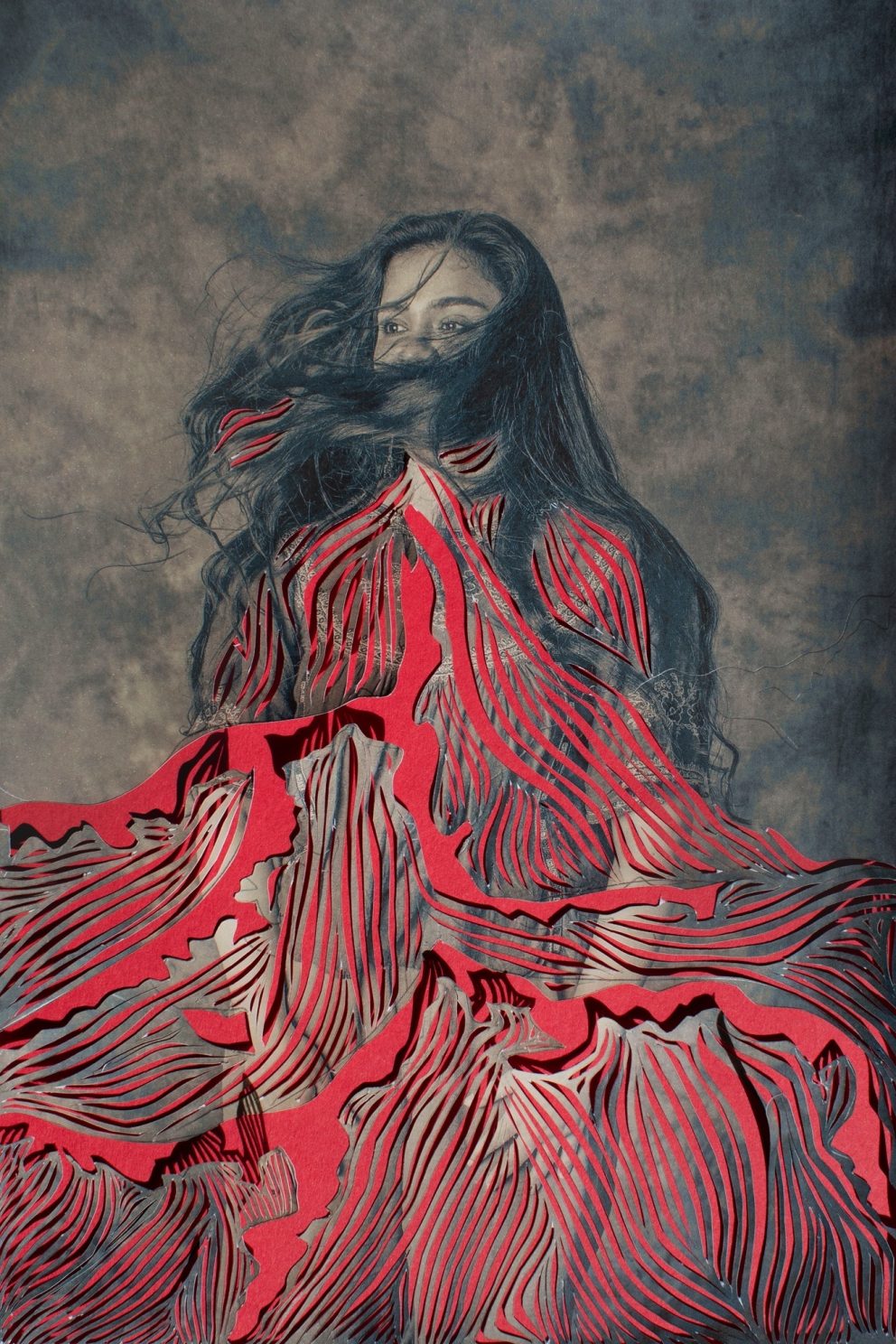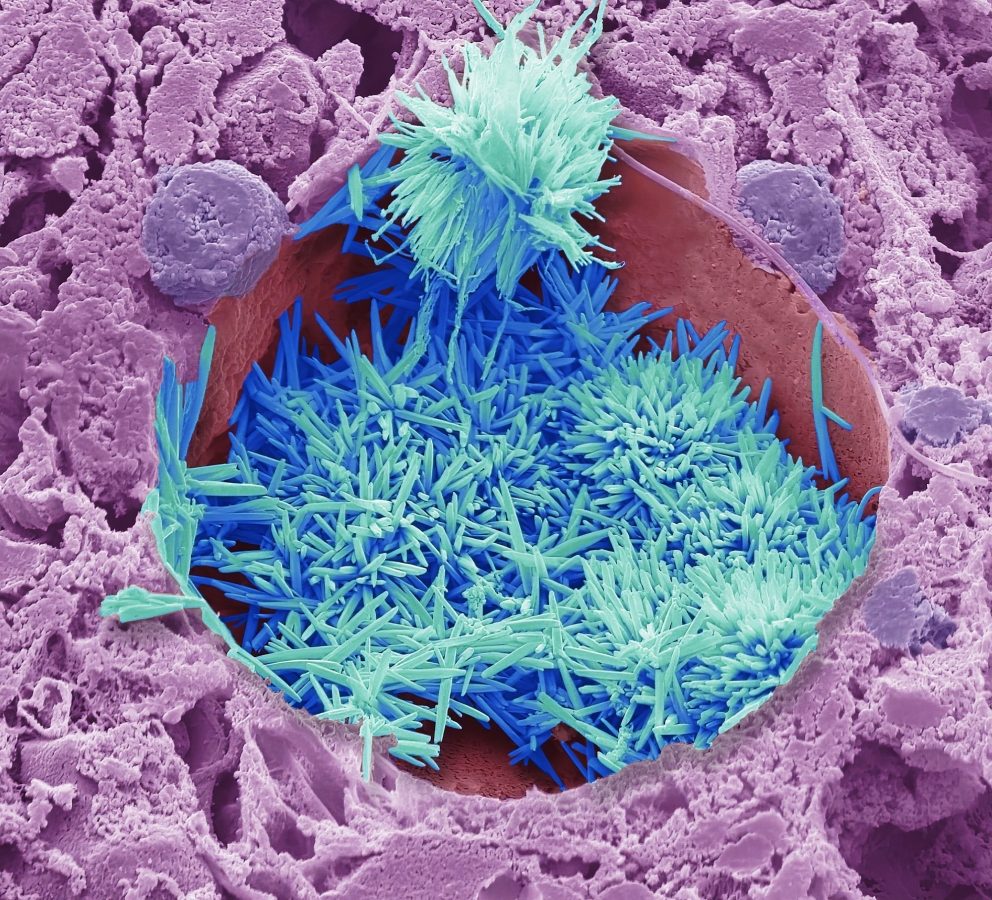
Click Here to download press images and captions
London, 16 July 2025 — Wellcome unveiled the winners of its 2025 Photography Prize at a ceremony held at the Francis Crick Institute in London. Three outstanding image makers, UK-based artist Sujata Setia, Bangladeshi documentary and street photographer Mithail Afrige Chowdhury, and UK-based electron microscopy specialist and science photographer Steve Gschmeissner, were each awarded a £10,000 prize. The winning images reflect how science and health shape people’s lives in complex and deeply personal ways, from the hidden toll of domestic abuse to the everyday realities of climate migration, to the microscopic processes that underpin heart disease.
Now in its 28th year, the Wellcome Photography Prize celebrates compelling imagery at the intersection of science, health and human experience. From documentary photography to microscopy and medical imaging, it highlights diverse perspectives on global health and the vital role of visual storytelling in creating a healthier future.
At the ceremony, the remaining finalists were each presented with a £1,000 prize, with a total of £52,000 awarded. The event was hosted by Professor Danielle George CBE, engineer, astrophysicist, science communicator and television presenter.
The top 25 entries are on display in the Wellcome Photography Prize 2025 exhibition, which is free and open to the public at the Francis Crick Institute, running from 17 July to 18 October 2025.
Lara Clements, Associate Director, Engagement, Wellcome says“The Wellcome Photography Prize offers image-makers a platform to showcase the impact of science and health on lives around the world. This year’s winning works stood out not only for their technical accomplishment, but for the care and collaboration behind them. Sujata Setia’s portraits raised powerful questions around dignity, confidentiality and sensitivity. Mithail Afrige Chowdhury’s image exemplified the value of being embedded in the community and explored themes of adaptation, illusion and fantasy in a compelling way. Steve Gschmeissner’s biomedical image impressed us with its precision and raised important questions about how scientific imagery is shared and understood by the public. We hope audiences will find the winners’ work moving, educational and inspiring, and enjoy the full exhibition at the Francis Crick Institute.”
The Winners
In the Storytelling Series category, Sujata Setia was recognised for A Thousand Cuts, a deeply collaborative portrait project developed with survivors of domestic abuse within South Asian communities. Each image is a composite of personal testimony, visual symbolism, and traditional craft. Setia worked with the women and with the charity SHEWISE to create portraits that protected anonymity without erasing identity, applying the Indian paper-cutting technique sanjhi to overlay each photograph. The results are intimate, powerful reflections on generational trauma, silence, survival, and the politics of representation. From the account of a woman forced into marriage twice by her father and left with lasting PTSD, to a mother determined to break the cycle of violence for her daughter, the series captures how abuse can become ingrained and normalised, and how art can offer a means of reclaiming narrative.
Sujata Setia says “This is a monumental recognition. A Thousand Cuts being selected for Wellcome Photography Prize affirms that health cannot be separated from the histories that shape it. And that domestic abuse is never a singular event; it leaves a direct, trans-generational imprint on health. As a child who grew up in a home where violence was a daily occurrence, I carry that trauma like another limb. This recognition validates not just my story, but the invisible, intangible, yet deeply scarring legacy of gender-based abuse. Domestic abuse is one of the most widespread global crimes; and yet remains among the least publicly acknowledged health crises. I hope this moment becomes a catalyst for deeper dialogue and scholarship around the interrelation between domestic abuse and health. That is our collective hope.”
Mithail Afrige Chowdhury was awarded the Striking Solo Photography prize for Urban Travel, a deceptively gentle image of a mother and daughter on a rooftop picnic in Dhaka. With few parks left in the city due to rapid urbanisation, this staged moment, a simple attempt to give a child a taste of nature, becomes an act of resilience. Nearly half of Dhaka’s population today are climate migrants, displaced by increasingly extreme weather, and Chowdhury’s work highlights the everyday consequences of these shifts: the loss of green space, of childhood rituals, of breath. The photograph is tender, composed, and yet filled with tension, a portrait of care and adaptation under invisible pressures.
Mithail Afrige Chowdhury says “When I got the news, the first thing I did was charge my camera—not to take a photo, but to restart something I thought I’d lost. I won’t dwell on personal or professional hardships, but this moment means more than I can say. I made this image two years ago, as part of a major project on climate change, urban sustainability, and public health .Then life intervened, and fear slowly pulled me away from the work I loved. But now, I can wake up with an objective. Because someone has my back. And that makes all the difference. Awards can feel technical but this recognition from Wellcome feels deeply human.”
The winner of The Marvels of Scientific and Medical Imaging was announced as Steve Gschmeissner, whose electron microscopy image Cholesterol in the Liver reveals cholesterol crystals (shown in blue) forming inside lipid-laden liver cells (purple). These microscopic shifts, invisible to the naked eye, can have deadly consequences: when cholesterol hardens from liquid to crystal, it damages blood vessels and contributes to heart disease and strokes. Gschmeissner’s colourised SEM image transforms this biological process into something visually striking, part data, part artwork. With a career spanning over four decades, and more than 10,000 images published in scientific journals, stamp collections, fashion collaborations, and music albums, his work exemplifies how imaging can bridge science and culture.
Steve Gschmeissner says “When I discovered that Wellcome had reintroduced the Marvels of Scientific and Medical Imaging category, I was delighted to enter such a prestigious competition. I was thrilled to be shortlisted, and winning first prize is undoubtedly one of the highlights of my 50-year career of trying to bring the wonders of the microscopic world to all.”
This year’s prize drew submissions from over 100 countries. The Top 25 entries featured over 30 individuals from 18 countries, spanning Bangladesh, Brazil, France, Germany, Greece, India, Italy, Myanmar, Peru, South Africa, Spain, Uganda, the UK, USA and beyond.
The winners were selected by an international judging panel comprising leading voices from photography, science, health and journalism. The panel was chaired by Melanie Keen, Director of Wellcome Collection, and included Caroline Hunter, Picture Editor at The Guardian; Daniella Zalcman, Photographer and Founder of Women Photograph; Benjamin Ryan, Independent Science Journalist; Elizabeth Wathuti, Environmental and Climate Activist; Esmita Charani, Associate Professor at the University of Cape Town; Helen Fisher, Professor of Developmental Psychopathology at King’s College London; Noah Green, Science Educator at the Beautiful Biology Initiative; and Mark Lythgoe, Director of the UCL Centre for Advanced Biomedical Imaging.
Wellcome Photography Prize Exhibition
Curated by Laurie Britton Newell and Ligaya Salazar, the Wellcome Photography Prize exhibition features images that reflect a wide spectrum of health experiences, from everyday routines to global challenges. Using techniques such as portraiture, cyanotypes, drone photography, and light and electron microscopy, the image makers show how health is lived, documented and researched around the world.
Many of the works respond to Wellcome’s core focus areas, mental health, climate and health, infectious disease and discovery research. Together, they reveal how these issues overlap and take shape in different cultural and geographic contexts. The result is a layered and often unexpected portrait of health today, told through voices and perspectives that are frequently overlooked.
Among this year’s highlights are Marks of Majesty: Vanessa by Julia Comita and Stephanie Francis, a portrait honouring the life and choices of a person impacted by breast cancer who opted for aesthetic flat closure, challenging assumptions around gender, illness and identity. Beautiful Disaster by Alexandru Radu Popescu shows a lake of toxic mining waste in Romania that continues to expand each year, an image of both striking beauty and environmental damage. Resilience Artist by Pyaephyo Thetpaing captures a craftsman in Myanmar who creates lacquerware using his foot, offering a broader reflection on health, disability and the role of cultural tradition in healing.
In the scientific imaging category, Ice and Fire Chronics by Ingrid Augusto, Kildare Rocha de Miranda and Vânia da Silva Vieira shows the structure of the parasite that causes Chagas disease, which affects millions across the Americas. Blooming Barrier by Lucy Holland presents goblet cells inside the gut of a child with Hirschsprung’s disease, offering insight into how cell structures influence lifelong digestive health. From Butterflies to Humans by Amaia Alcalde Anton reveals the brain of a butterfly mid-metamorphosis, part of a study into neurogenesis with implications for human brain development.
In addition to the Top 25 entries, the exhibition also features Things We Left Unseen, a youth-led photography project developed by Cape Town-based public health organisation Eh!woza. Created in collaboration with young people in the township of Khayelitsha, the project explores health, stigma, and daily life through the eyes of a generation growing up with high HIV and TB burdens, but also with hope and agency.
The exhibition is hosted at the Francis Crick Institute, reflecting a shared commitment to making science more visible through culture.
Ali Bailey, Director of Communications and Public Engagement at the Francis Crick Institute, said: “We are delighted to host the top images from the Wellcome Photography Prize, showcasing the power of visual storytelling in health and science. The images explore a number of themes that resonate with Crick research, from the health effects of air pollution to neurogenesis. We hope visitors will be moved by the stories behind these incredible photos and also inspired by how beautiful science can be.”
ENDS
Notes to Editors:
Media Contacts
Sophie Balfour-Lynn
Sutton
Sophiebl@suttoncomms.com
Mary-Kate Findon
Wellcome
mediaoffice@wellcome.org
Winners’ Biographies
Sujata Setia (Storytelling Series)
Sujata Setia is an Indian-born, UK-based artist who's socially engaged, research-led practice combines photography with traditional artistic interventions to explore subaltern histories, cultural imperialism, and the politics of representation. With a background in journalism and a Master’s in International Relations from King’s College London, her work draws on academic research and community collaboration to centre marginalised voices, particularly through a feminist lens.
Her acclaimed series Changing the Conversation marked a shift away from her earlier portraiture, interrogating the cultural and political construction of beauty. In 2024, she was awarded the Culture King’s Grant to develop a lens-based, interdisciplinary project exploring the role of workplace structures for embroidery women artisans in Kashmir. She also recently received the Centre for British Photography Realisation Grant to further expand the scope of A Thousand Cuts, a powerful body of work amplifying the voices of survivors of gender-based abuse.
Setia’s work has received major international recognition, including the Sony World Photography Award (Creative category, 2024), LensCulture Critics’ Choice Award (2024), Prix Pictet nomination (2023), BJP Female in Focus (2022), and Photographer of the Year at the Tokyo International Foto Awards (2021). Her photography has been exhibited widely—from Somerset House in London to Times Square in New York—and featured in leading publications including The Guardian, CNN, BBC, and Forbes.
Beyond her visual practice, Setia contributes to education and advocacy through teaching ethical storytelling and photography at EFTI in Madrid, and through collaborations with organisations such as Shewise and WERESTART in the UK. Her work consistently seeks to reshape public narratives around identity, power, and care through interdisciplinary, justice-focused art.
Mithail Afrige Chowdhury (Striking Solo Photography)
Mithail Afrige Chowdhury is a documentary and street photographer based in Dhaka, Bangladesh. Raised in the city of Khulna, his photography is deeply rooted in the lives of ordinary people. “Since then, I have always tried to understand people’s lives—their pain, joy, and the complexities shaped by social, economic, political, and environmental changes.”
He began photography in 2015 and chose to document what he knew best: life around him. His work has captured the Rohingya refugee crisis, the effects of climate change on Bangladesh (an ongoing project), major festivals, urban water crises, slum fires, and the Covid-19 pandemic.
Mithail has won numerous international photography awards, including the Life Press Photo Award (Ukraine), Xposure International Photography Competition (UAE), Compass Photo Competition by the University of Oxford (UK), and contests in China. His work has been featured in The Guardian, The Daily Sun, The Times of India, Global Photography, and publications from the University of Oxford, ASCE, and Saturday Magazine.
Steve Gschmeissner (The Marvels of Medical and Scientific Imaging)
Steve Gschmeissner is a UK-based photographer and electron microscopy specialist whose career spans over four decades in scientific imaging. After earning a degree in Zoology, he spent 25 years at the Royal College of Surgeons, eventually leading the electron microscopy services, followed by 15 years leading the EM unit at Cancer Research UK.
In 2002, Gschmeissner retired early to dedicate himself to freelance photography, specialising in Scanning Electron Microscopy (SEM). Over the past two decades, he has built an archive of more than 10,000 images, widely published across scientific, medical, and popular media. His work has featured in everything from textbooks and advertising to art, fashion, and music, appearing on album covers for Peter Gabriel, artworks by Damien Hirst, on US Postal Service stamps, and as visual inspiration for an Iris van Herpen’s fashion collection.
In 2021, he was awarded the Lennart Nilsson Award for his lifelong contribution to microscopy. His images continue to bridge the worlds of science and visual culture, offering new ways of seeing the invisible.
Full list of Finalists - Top 25 Entries
Striking solo photography
- Searching for Life – Sandipani Chattopadhyay (India)
- Urban Travel – Mithail Afrige Chowdhury (Bangladesh)
- Marks of Majesty: Vanessa – Julia Comita & Stephanie Francis (USA)
- Musa – Marijn Fidder (Uganda/Netherlands)
- The Light Will Come – Dora Grivopoulou (Greece)
- Cricket is My Emotion – Ziaul Huque (Bangladesh)
- Pie-by-Sam – Reatile Moalusi (South Africa)
- Beautiful Disaster – Alexandru Radu Popescu (Romania)
- Resilience Artist – Pyaephyo Thetpaing (Myanmar)
- Stereo EEG Self-Portrait – Muir Vidler (UK)
- Transparent Curtains – Oded Wagenstein (Israel)
- Self, Five Years On – Georgie Wileman (UK)
A storytelling series
- The Loss Mother’s Stone – Nancy Borowick (US Virgin Islands)
- A Dream to Cure Water – Ciril Jazbec (UK)
- Nemo’s Garden – Giacomo d’Orlando (Italy)
- A Thousand Cuts – Sujata Setia (UK)
- I Spend 150 Hours Alone Each Week – Madeleine Waller (Australia/UK)
The marvels of scientific and medical imaging
- From Butterflies to Humans – Amaia Alcalde Anton (UK)
- Ice and Fire Chronics: The Chagas Disease Invader – Ingrid Augusto, Kildare Rocha de Miranda & Vânia da Silva Vieira (Brazil)
- Cholesterol in the Liver – Steve Gschmeissner (UK)
- Blooming Barrier – Lucy Holland (UK)
- Submarine Fever – Jander Matos & Joaquim Nascimento (Brazil)
- Organoids – Oliver Meckes & Nicole Ottawa, Eye of Science (Germany)
- I’ve Got You, Under My Skin: Microplastics in Mammalian Tissue – P. Stephen Patrick & Olumide Ogunlade (UK)
- Brixton Road, Lambeth – Marina Vitaglione (France/UK)
Exhibition Details
Wellcome Photography Prize 2025 exhibition is curated by Laurie Britton Newell and Ligaya Salazar
At the Francis Crick Institute, 1 Midland Road, London, NW1 1AT
17 July – 18 October 2025
Open Wednesdays to Saturdays, 10am-4pm (Wednesdays until 8pm)
Admission free
About Wellcome
Wellcome supports science to solve the urgent health challenges facing everyone. We support discovery research into life, health and wellbeing, and we’re taking on three worldwide health challenges: mental health, infectious disease and climate and health.
Follow the prize:
Instagram: @wellcomephotoprize
Wellcome Photography Prize 2025 | Wellcome
About the Francis Crick Institute
We are delighted that the Crick are hosting this year’s Wellcome Photography Prize exhibition.
The Francis Crick Institute is a biomedical discovery institute with the mission of understanding the fundamental biology underlying health and disease. Its work helps improve our understanding of why disease develops which promotes discoveries into new ways to prevent, diagnose and treat disease.
An independent organisation, its founding partners are the Medical Research Council (MRC), Cancer Research UK, Wellcome, UCL (University College London), Imperial College London and King’s College London.
The Crick was formed in 2015, and in 2016 it moved into a brand new state-of-the-art building in central London which brings together 1500 scientists and support staff working collaboratively across disciplines, making it the biggest biomedical research facility under a single roof in Europe.





